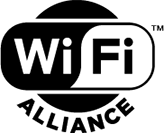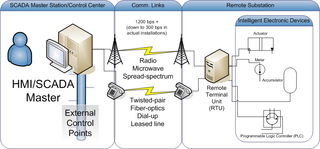
IEEE 802.11 is part of the IEEE 802 set of local area network (LAN) protocols, and specifies the set of media access control (MAC) and physical layer (PHY) protocols for implementing wireless local area network (WLAN) Wi-Fi computer communication in various frequencies including, but not limited to, 2.4 GHz, 5 GHz, 6 GHz, and 60 GHz frequency bands.
Power-line communication carries data on a conductor that is also used simultaneously for AC electric power transmission or electric power distribution to consumers.
IEEE 802.15.4 is a technical standard which defines the operation of low-rate wireless personal area networks (LR-WPANs). It specifies the physical layer and media access control for LR-WPANs, and is maintained by the IEEE 802.15 working group, which defined the standard in 2003. It is the basis for the Zigbee, ISA100.11a, WirelessHART, MiWi, 6LoWPAN, Thread and SNAP specifications, each of which further extends the standard by developing the upper layers which are not defined in IEEE 802.15.4. In particular, 6LoWPAN defines a binding for the IPv6 version of the Internet Protocol (IP) over WPANs, and is itself used by upper layers like Thread.

Power over Ethernet, or PoE, describes any of several standards or ad hoc systems that pass electric power along with data on twisted pair Ethernet cabling. This allows a single cable to provide both data connection and electric power to devices such as Wireless Access Points (WAPs), Internet Protocol (IP) cameras, and Voice over Internet Protocol (VoIP) phones.

The Wi-Fi Alliance owns the Wi-Fi trademark. Manufacturers may use the trademark to brand certified products that have been tested for interoperability.
HomePlug is the family name for various power line communications specifications under the HomePlug designation, with each offering unique performance capabilities and coexistence or compatibility with other HomePlug specifications.
IEC 61850 is an international standard defining communication protocols for intelligent electronic devices at electrical substations. It is a part of the International Electrotechnical Commission's (IEC) Technical Committee 57 reference architecture for electric power systems. The abstract data models defined in IEC 61850 can be mapped to a number of protocols. Current mappings in the standard are to MMS, GOOSE, SMV, and soon to Web Services. These protocols can run over TCP/IP networks or substation LANs using high speed switched Ethernet to obtain the necessary response times below four milliseconds for protective relaying.
The Precision Time Protocol (PTP) is a protocol used to synchronize clocks throughout a computer network. On a local area network, it achieves clock accuracy in the sub-microsecond range, making it suitable for measurement and control systems. PTP is currently employed to synchronize financial transactions, mobile phone tower transmissions, sub-sea acoustic arrays, and networks that require precise timing but lack access to satellite navigation signals.
Power-system automation is the act of automatically controlling the power system via instrumentation and control devices. Substation automation refers to using data from Intelligent electronic devices (IED), control and automation capabilities within the substation, and control commands from remote users to control power-system devices.

Distributed Network Protocol 3 (DNP3) is a set of communications protocols used between components in process automation systems. Its main use is in utilities such as electric and water companies. Usage in other industries is not common. It was developed for communications between various types of data acquisition and control equipment. It plays a crucial role in SCADA systems, where it is used by SCADA Master Stations, Remote Terminal Units (RTUs), and Intelligent Electronic Devices (IEDs). It is primarily used for communications between a master station and RTUs or IEDs. ICCP, the Inter-Control Center Communications Protocol, is used for inter-master station communications. Competing standards include the older Modbus protocol and the newer IEC 61850 protocol.
IEEE 802.11d-2001 is an amendment to the IEEE 802.11 specification that adds support for "additional regulatory domains". This support includes the addition of a country information element to beacons, probe requests, and probe responses. The country information elements simplifies the creation of 802.11 wireless access points and client devices that meet the different regulations enforced in various parts of the world. The amendment has been incorporated into the published IEEE 802.11-2012 standard.
The IEEE Std 1901-2010 is a standard for high speed communication devices via electric power lines, often called broadband over power lines (BPL). The standard uses transmission frequencies below 100 MHz. This standard is usable by all classes of BPL devices, including BPL devices used for the connection to Internet access services as well as BPL devices used within buildings for local area networks, smart energy applications, transportation platforms (vehicle), and other data distribution applications.
A rugged, or ruggedizedcomputer is a computer specifically designed to operate reliably in harsh usage environments and conditions, such as strong vibrations, extreme temperatures and wet or dusty conditions. They are designed from inception for the type of rough use typified by these conditions, not just in the external housing but in the internal components and cooling arrangements as well.

A phasor measurement unit (PMU) is a device used to estimate the magnitude and phase angle of an electrical phasor quantity in the electricity grid using a common time source for synchronization. Time synchronization is usually provided by GPS or IEEE 1588 Precision Time Protocol, which allows synchronized real-time measurements of multiple remote points on the grid. PMUs are capable of capturing samples from a waveform in quick succession and reconstructing the phasor quantity, made up of an angle measurement and a magnitude measurement. The resulting measurement is known as a synchrophasor. These time synchronized measurements are important because if the grid’s supply and demand are not perfectly matched, frequency imbalances can cause stress on the grid, which is a potential cause for power outages.

A smart grid is an electrical grid which includes a variety of operation and energy measures including smart meters, smart appliances, renewable energy resources, and energy efficient resources. Electronic power conditioning and control of the production and distribution of electricity are important aspects of the smart grid.
IEEE 802.11b-1999 or 802.11b is an amendment to the IEEE 802.11 wireless networking specification that extends throughput up to 11 Mbit/s using the same 2.4 GHz band. A related amendment was incorporated into the IEEE 802.11-2007 standard.
The European Marine Energy Centre (EMEC) Ltd is a UKAS accredited test and research centre focusing on wave and tidal power development based in the Orkney Islands, UK. The Centre provides developers with the opportunity to test full-scale grid-connected prototype devices in unrivalled wave and tidal conditions.

IEEE 1394 is an interface standard for a serial bus for high-speed communications and isochronous real-time data transfer. It was developed in the late 1980s and early 1990s by Apple in cooperation with a number of companies, primarily Sony and Panasonic. Apple called the interface FireWire. It is also known by the brands i.LINK (Sony), and Lynx.
In 2009, a European Commission initiative resulted in the specification of a common external power supply for use with data-enabled mobile phones sold in the European Union. The external power supply is the AC electric power adapter that converts household AC electricity voltages to the much lower DC voltages needed to charge a mobile phone's internal battery. Although compliance is voluntary, a majority of the world's largest mobile phone manufacturers agreed to make their applicable mobile phones compatible with Europe's common external power supply specification.

IEEE Smart Grid is an initiative launched by IEEE to help provide expertise and guidance for individuals and organizations involved in the modernization and optimization of the power grid, better known as the "smart grid". IEEE Smart Grid encompasses an array of activities, including development of new smart grid-related standards, best practices, publications, and conferences and educational opportunities.








